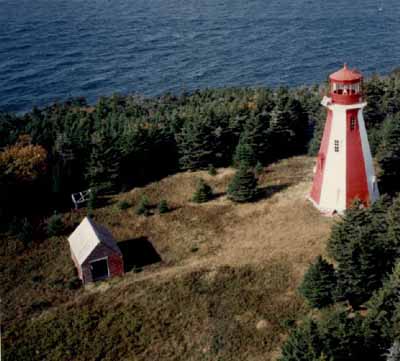Lighttower
Recognized Federal Heritage Building
Henry Island, Nova Scotia

Aerial view
© Transport Canada / Transports Canada, 1990.
Address :
Port Hood, Henry Island, Nova Scotia
Recognition Statute:
Treasury Board Policy on Management of Real Property
Designation Date:
1991-08-19
Dates:
-
1902 to 1902
(Construction)
Event, Person, Organization:
-
Engineering Branch, Department of Marine and Fisheries
(Architect)
Custodian:
Fisheries and Oceans Canada
FHBRO Report Reference:
90-290
DFRP Number:
67639 00
Description of Historic Place
The Lighttower at Henry Island is situated on an island promontory close to Port Hood, on the west coast of Cape Breton. It is a medium-height, wooden tower with a cast-iron lantern. The classical detail and elegant proportions of this tapered octagonal tower contribute to its striking appearance. The designation is confined to the footprint of the building.
Heritage Value
The Lighttower is a Recognized Federal Heritage Building because of its historical associations, and its architectural and environmental value.
Historical Value
The Lighttower is associated with campaigns to provide aids to navigation in coastal locations. The tower is also associated with an important period of growth for Port Hood at the beginning of a period of expansion in the early 1900s.
Architectural Value
The Lighttower is a very good example of a tapered tower with symmetrical massing, classical details and plank on plank construction. The simple form of the tower is enhanced by the facades executed in painted wooden shingles without corner boards and by the fine-scale cove boarding of the cornice, all of which are evidence of its good craftsmanship.
Environmental Value
The Lighttower at Henry Island reinforces the present character of its coastal maritime setting and is a familiar landmark in the local area.
Sources:
Federal Heritage Building Review Office Building Report 90-290; Heritage Character Statement, 90-290.
Character-Defining Elements
The character-defining elements of the Lighttower should be respected.
Its aesthetic and good craftsmanship, for example: the symmetrical massing and octagonal, tapered form of the tower and octagonal cast-iron lantern with cone topped ventilator; the plank on plank wood construction; the facades executed in painted wood shingles without corner boards and the fine-scaled boarding of the cornice; the projecting pedimented window and door hoods, the lantern platform and the flared cove; the painted steel lantern railings with tube and elbow joint construction; the paint scheme of white and red painted sides; the multi-pane wood sash windows and the panelled door.
The manner in which the Lighttower reinforces the present character of its maritime coastal setting and is a familiar landmark in the region, as evidenced by: the picturesque qualities of its design and form, which complement the natural environment; its high visibility and familiarity to mariners and to residents of the Port Hood region.
Heritage Character Statement
Disclaimer -
The heritage character statement was developed by FHBRO to explain the reasons for the designation of a federal heritage building and what it is about the building that makes it significant (the heritage character). It is a key reference document for anyone involved in planning interventions to federal heritage buildings and is used by FHBRO in their review of interventions.
The lighttower at Henry Island was constructed in 1902. The design was prepared by the Engineering Branch of the Department of Marine and Fisheries. The building is currently a fully automated lighttower. The Canadian Coast Guard is the custodian. See FHBRO Building Report 90-290.
Reasons for Designation
The lighttower was designated Recognized for its architectural importance and its environmental significance as well as for its historical associations.
The classical detail precedents and elegant proportions of this tapered octagonal tower contribute to its striking appearance. The lighttower has an attractive profile enhanced by the pedimented door and window heads and the cove cornice supporting the gallery. The well-proportioned lantern contributes to the characteristic lighttower profile.
The scale and silhouette of the Henry Island lighttower contribute to the maritime environment. Situated on an island promontory, the tower maintains its historical relationship with the natural landscape. To mariners of the Port Hood region, the lighttower is a familiar landmark.
The lighthouse construction is illustrative of campaigns to provide aids to navigation for coastal locations. The tower is also associated with an important period of growth for Port Hood at the turn of the century.
Character Defining Elements
The heritage character of the Henry Island lighttower resides in its overall massing, profile, architectural features, construction materials and site relationships.
The elegant proportions of the medium-height, tapered octagonal structure with cove profiled cornice contribute to its graceful silhouette. The octagonal cast-iron lantern with cone-topped ventilator is well-proportioned to the scale of the tower. This relationship should be respected. The symmetrical massing and profile, including the relationship of lantern to tower shaft, should not be compromised.
The simple form of the lighttower is enhanced by facades executed in white-painted horizontal wood shingles without corner boards, and by the fine-scaled cove boarding of the cornice. The projecting pedimented window and door hoods, the lantern platform, and the flared cove follow classical detail precedents and add textural interest and visual contrast to the simple tower form. The siding would benefit from an ongoing maintenance program. The lighttower structure is of unusual plank on plank construction which should be maintained.
Painted steel is used for the lantern railings. Their utilitarian tube and elbow joint construction reflects the functional utility of the early industrial lighttower components. The octagonal guardrail form follows the lantern shape. The paint scheme, alternating white and red painted sides, is a striking feature which should be maintained if operationally appropriate.
The multi-paned wood sash windows contribute to the character of the building. The paneled door also appears to be original and should be maintained.
The small cleared site is undeveloped, with a simple ground cover reflecting the functional, low maintenance aspect of the site. This is appropriate and should be respected.